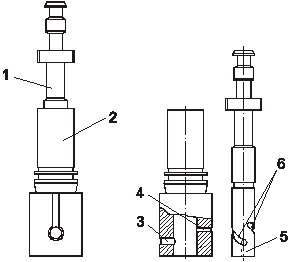Sjemnik Tnvd M51 Chertezh
MR艞@ 21294̋L܂B ɋL. Page-1 Page-2 Page-3 Page-4 Page-5 Page-6 Page-7 Page-8 Page-9 Page-10 Page-11 Page-12 Page-13 Page-14 Page-15 Page-16 Page-17 Page-18 Page-19 Page-20 Page-21 Page-22 Page-23 Page-24 Page-25 Page-26 Page-27 Page-28 Page-29 Page-30 Page-31 Page-32 Page-33 Page-34 Page-35 Page-36 Page-37 Page-38 Page-39 Page-40 Page-41 Page-42 Page-43 Page-44 Page-45 Page-46 Page-47 Page.

Bayonets from Sweden left to right: m/96 old type, m/96, m/1914, m/1915, m/39 and m/65 Bayonet Length over all Length of blade Intended for weapon m/1896 with flat locking stud (early production) (Rare) 335 mm 212 mm Rifle m/1896 m/1896 with conical locking stud. 335 mm 212 mm Rifle m/1896, m/1938 and automatic rifle Ag m/42 m/1914 460 mm 332 mm Carbine m/1894/14 and Submachine gun m/1945C m/1915 (Rare) 630 mm 500 mm Carbine m/1894/14 and Submachine gun m/1945C m/1939 380 mm 252 mm Only for Rifle m/1939 (Not for m/1940) m/1965 310 mm 168 mm Ak4 and Ak5 Bayonet m/1896. Swedish knife bayonet m/1896 apart for the Swedish Mauser m/1896, m/1938 and Ag m/42 (Ljungman rifle). These bayonets were delivered to the Army in pieces like this and upon arrival assembled to complete bayonets. We ca n notice that the construction will only take a short blade.
The short tang will never allow a long blade and the locking construction was too weak for a long blade. The first bayonets from 1896 were delivered with a flat locking device, but these were soon exchanged for the conical loc king device like on this bayonet. This bayonet was made in Eskilstuna Iron manufacture company (EJ AB) which is stamped on one side of the ricasso. On the other side of the ricasso are the Swedish Royal Acceptance Crown and a number. These bayonets were used by the Swedish Army for at least 100 years! These two bayonets were intended for the use with carbines m/1894-15.
The long bayonet (M/1915) has basically been used by the Navy. The Navy used a capital 'M/' for designation while the Army used lower case letter 'm/'. During the period 1935-1939 these long bayonets were used by the guards for the main entrance of the Naval base of Karlskrona. My father told me that they for them for guard duty without any gun! The shorter bayonet (m/1914) has been used by other troops equipped with carbines like the cavalry. Nowadays they are used for guard and parade duty in combination with Submachine gun m/1945. To see bayonets for trials please visit Paer Holmbacks site: [] WARNING THESE m/1896 ARE FAKES: First the recently appeared Chinese copy of m/1896 with thinner handle and off side stampings.
It is amazing that anybody will take the effort to copy the Swedish bayonet m/1896 which is very common and costs only $50 as original! --------------------------------------------------------------------------- And here a cut off and changed m/96 to a Parade bayonet Compare this fake with the original one here, which I mentioned before.

Service bulletin no. 48 (9-8-1979) Some TS-120S users may complain of a hum during SSB operation, which may be caused by RF feedback. There may be various reasons for this complaint. • Bad feedline and antenna system ground. • Poor Mic hookup or shielding. • Vertical antenna with poor or no radial system. Myspace english version.
• For base operation with other than a PS-30 Power supply: Poor regulation and insufficient filtering in the supply. • Linear amplifier creating hi RF field near the operating position. • RF induced back into the power supply causing falsie protection (other than PS-30). • RF pickup by any cables to or from ancillary equipment. Prevention is the best cure. For those cases where all normal measures have been tried, try installing a.01uF bypass cap across the mic input jack between pins 1 and 4. Some AFSK operators may have similar RF feedback problems with TS-820S or TS-520S.
Bypass the mic ground pin to the chassis, pin 3 to 4 and in extreme cases, install a ferrite bead on the Mic coax center conductor at the microphone connector. Please annotate your service manual.
TS-120S VFO Stability (Supercedes 7/9/79 bulletin) VFO drift characteristics may be improved by changing component values and location in the VFO. This change applies to serial numbers before 00100001. Note: DO NOT disturb lead dress or component placement while working inside the VFO. • Remove the VFO unit by four 3mm hex head bolts.
• Withdraw out the front panel and unplug the leads. • Remove the VFO cover by 5 phillips head screws. • Remove C17, and C18 from the PCB. Thes may be cut flush to the board.
• Reposition the Ground terminal for the Variabel Capacitor by heating the post and pushing it through to the opposite side of the PCB. • Install paralleled 10pF green and 18pF yellow caps from the bottom tank coil terminal (LH) to the modified Ground post. Position the caps near the coil, not the PCB. Make certain the ground lead doesn't touch the coil or coil mounting. • To reassemble, perform steps 3,2,1.